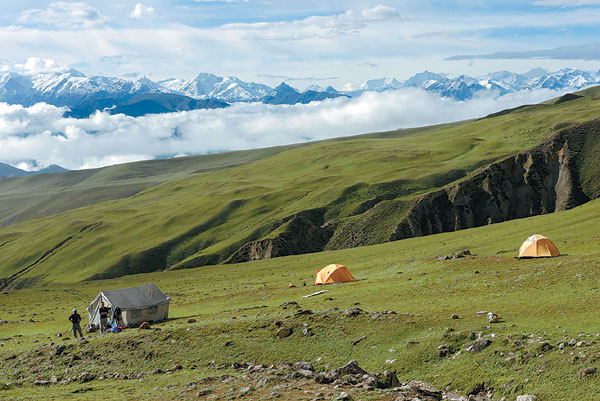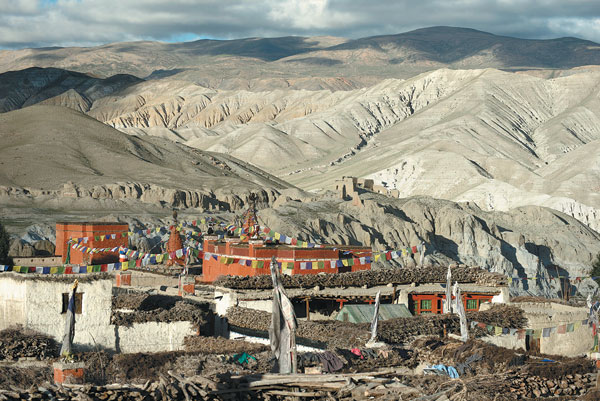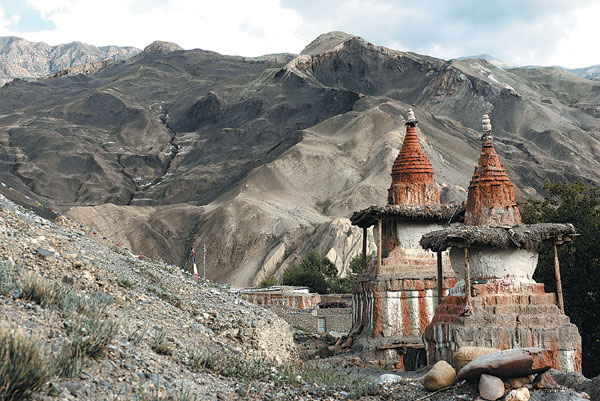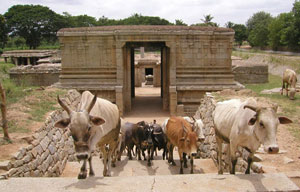Myths and mountains
Updated: 2013-02-17 13:28
By Edward Wong (China Daily/Agencies)
|
||||||||
 |
|
Trekkers' camps dotted the high grasslands. |
 |
|
A closer view of Lo Manthang, the walled capital of Mustang, where visitors should proceed slowly and explore some of the hidden corners. |
 |
|
Chortens, or samll Buddhist stupas, stand in the village. |
The southern brae of the Himalayas in Nepal offers trekkers landscapes and glimpses of faith that resonate across time, Edward Wong discovers.
Mustang was a caldron of myth, as I discovered on a 16-day trek in September. Modernity was creeping in to the area, but the stories that people told had evolved little over centuries. As I walked through the valleys and white-walled villages, I heard tales that brought alive the harsh land, a place of deep ravines and stinging winds and ancient cave homes. I had longed to visit Mustang ever since I got a glimpse of it while trekking the nearby Annapurna Circuit 12 years ago.
On the northern arc of the circuit is the village of Kagbeni, with its red-walled monastery. To the north is an expansive gorge carved by the Kali Gandaki River in Nepal.
Beyond lies Upper Mustang, or the Kingdom of Lo, forbidden to those who did not have a permit from the Nepalese government.
As a boy, I had seen my mother embrace certain Buddhist beliefs, and later I began walking paths in the Himalayas in search of something transcendent in the landscape and the abiding expressions of faith.
Last year, nearly 3,000 tourists entered Upper Mustang, according to statistics at a government office in Kagbeni, an increase of more than 25 percent from about three years earlier.
The permit fee for entering Upper Mustang - $500 for 10 days, and $10 for each additional day - deters many travelers. The low numbers, though, are welcomed by those trekkers looking to avoid the busy trails.
After a week in the Katmandu Valley, we flew north. Many trekkers rush from Kagbeni to Lo Manthang, the walled capital of Mustang, and back in 10 days. We decided to go more slowly and explore some of the hidden corners along the way.
Summertime in Nepal is when some of its last remaining nomads set up camp in the high grasslands west of Lo Manthang.
In that area, too, are peaks of more than 6,100 meters beckoning to be explored.
The eastern half of Mustang is more remote, and it has some of the best-preserved Tibetan Buddhist cave art in the world.
Each day of the trek, I marveled at how the landscape of Mustang was unlike anything I had seen in the Himalayas.
It was a place of canyon vistas revolving around the enormous valley of the Kali Gandaki.
|
|
|

 'Taken 2' grabs movie box office crown
'Taken 2' grabs movie box office crown
 Rihanna's 'Diamonds' tops UK pop chart
Rihanna's 'Diamonds' tops UK pop chart
 Fans get look at vintage Rolling Stones
Fans get look at vintage Rolling Stones
 Celebrities attend Power of Women event
Celebrities attend Power of Women event
 Ang Lee breaks 'every rule' to make unlikely new Life of Pi film
Ang Lee breaks 'every rule' to make unlikely new Life of Pi film
 Rihanna almost thrown out of nightclub
Rihanna almost thrown out of nightclub
 'Dark Knight' wins weekend box office
'Dark Knight' wins weekend box office
 'Total Recall' stars gather in Beverly Hills
'Total Recall' stars gather in Beverly Hills
Most Viewed
Editor's Picks

|

|

|

|

|

|
Today's Top News
Boston bombing suspect reported cornered on boat
7.0-magnitude quake hits Sichuan
Cross-talk artist helps to spread the word
'Green' awareness levels drop in Beijing
Palace Museum spruces up
First couple on Time's list of most influential
H7N9 flu transmission studied
Trading channels 'need to broaden'
US Weekly

|

|










